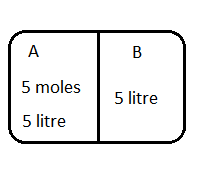Answer
405.3k+ views
Hint:Gases can perform work through the expansion or compression against a constant external pressure. Work done by gases is also sometimes called pressure-volume work. When work is done on the gas, the volume of the gas further increases, and the work done is positive.
Complete step by step answer:
Since there is no heat exchange with the surroundings, it means it is an adiabatic process,
Work done$ = p\Delta V$
Pressure–volume work (or $PV$work) occurs when the volume V of the system changes. Pressure–volume work is usually measured in units of litre-atmospheres.
PV work is an important topic in chemical thermodynamics
Given,
$P = 4atm$
The initial volume, ${V_1} = 5$L
After removing the partition, the final volume is ${V_2} = 5 + 5 = 10$L
Work done$ = p\Delta V$
$
= p({V_2} - {V_1}) \\
= 4atm(10 - 5)L \\
= 20atmL \\
$
Note:
-Work is the energy required to maneuver something against a force.
-The energy of a system can change thanks to work or other kinds of energy transfer like heat. Negative work occurs when a system does work in the environment. When the gas does work, the amount of gas increases, and therefore the work done is negative.
-When a system does work on the environment, the system's internal energy decreases. When a system has work done thereon, the interior energy of the system increases. Like the heat, the energy change from work always occurs as a part of a process, as in a system can work, but doesn't contain work.
-When the gas expands against an external pressure, the gas needs to transfer some energy to the environment. Thus, the negative work decreases the energy of the gas. When the gas is compressed, energy is transferred to the gas therefore the energy of the gas increases because of positive work.
Complete step by step answer:
Since there is no heat exchange with the surroundings, it means it is an adiabatic process,
Work done$ = p\Delta V$
Pressure–volume work (or $PV$work) occurs when the volume V of the system changes. Pressure–volume work is usually measured in units of litre-atmospheres.
PV work is an important topic in chemical thermodynamics
Given,
$P = 4atm$
The initial volume, ${V_1} = 5$L
After removing the partition, the final volume is ${V_2} = 5 + 5 = 10$L
Work done$ = p\Delta V$
$
= p({V_2} - {V_1}) \\
= 4atm(10 - 5)L \\
= 20atmL \\
$
Note:
-Work is the energy required to maneuver something against a force.
-The energy of a system can change thanks to work or other kinds of energy transfer like heat. Negative work occurs when a system does work in the environment. When the gas does work, the amount of gas increases, and therefore the work done is negative.
-When a system does work on the environment, the system's internal energy decreases. When a system has work done thereon, the interior energy of the system increases. Like the heat, the energy change from work always occurs as a part of a process, as in a system can work, but doesn't contain work.
-When the gas expands against an external pressure, the gas needs to transfer some energy to the environment. Thus, the negative work decreases the energy of the gas. When the gas is compressed, energy is transferred to the gas therefore the energy of the gas increases because of positive work.
Recently Updated Pages
How many sigma and pi bonds are present in HCequiv class 11 chemistry CBSE

Why Are Noble Gases NonReactive class 11 chemistry CBSE

Let X and Y be the sets of all positive divisors of class 11 maths CBSE

Let x and y be 2 real numbers which satisfy the equations class 11 maths CBSE

Let x 4log 2sqrt 9k 1 + 7 and y dfrac132log 2sqrt5 class 11 maths CBSE

Let x22ax+b20 and x22bx+a20 be two equations Then the class 11 maths CBSE

Trending doubts
Fill the blanks with the suitable prepositions 1 The class 9 english CBSE

At which age domestication of animals started A Neolithic class 11 social science CBSE

Which are the Top 10 Largest Countries of the World?

Give 10 examples for herbs , shrubs , climbers , creepers

Difference between Prokaryotic cell and Eukaryotic class 11 biology CBSE

Difference Between Plant Cell and Animal Cell

Write a letter to the principal requesting him to grant class 10 english CBSE

Change the following sentences into negative and interrogative class 10 english CBSE

Fill in the blanks A 1 lakh ten thousand B 1 million class 9 maths CBSE




